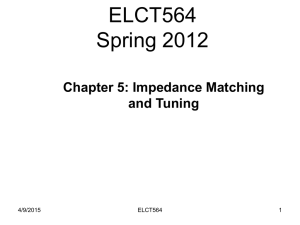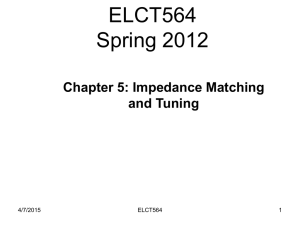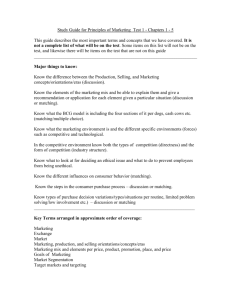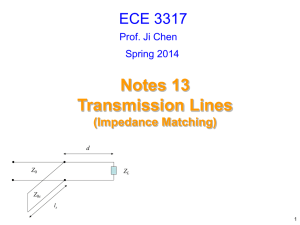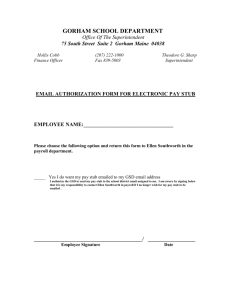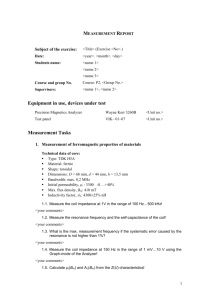TASK B Impedance Matching - Electrical and Computer Engineering
advertisement
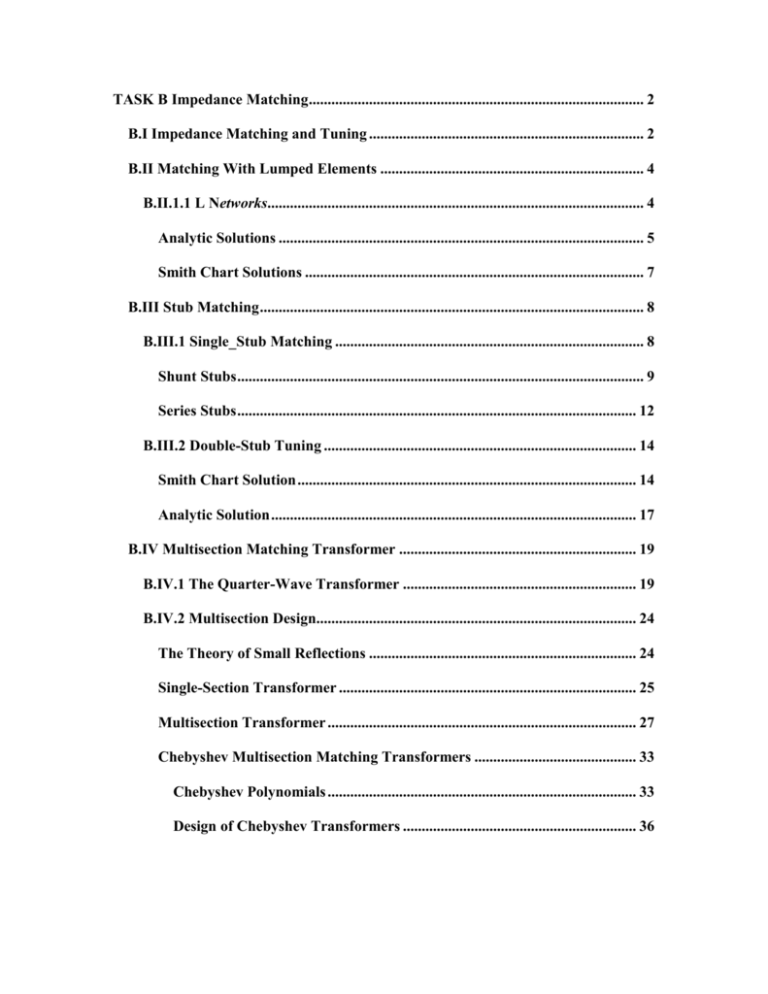
TASK B Impedance Matching ......................................................................................... 2 B.I Impedance Matching and Tuning ......................................................................... 2 B.II Matching With Lumped Elements ...................................................................... 4 B.II.1.1 L Networks.................................................................................................... 4 Analytic Solutions ................................................................................................. 5 Smith Chart Solutions .......................................................................................... 7 B.III Stub Matching ...................................................................................................... 8 B.III.1 Single_Stub Matching .................................................................................. 8 Shunt Stubs ............................................................................................................ 9 Series Stubs .......................................................................................................... 12 B.III.2 Double-Stub Tuning ................................................................................... 14 Smith Chart Solution .......................................................................................... 14 Analytic Solution ................................................................................................. 17 B.IV Multisection Matching Transformer ............................................................... 19 B.IV.1 The Quarter-Wave Transformer .............................................................. 19 B.IV.2 Multisection Design..................................................................................... 24 The Theory of Small Reflections ....................................................................... 24 Single-Section Transformer ............................................................................... 25 Multisection Transformer .................................................................................. 27 Chebyshev Multisection Matching Transformers ........................................... 33 Chebyshev Polynomials .................................................................................. 33 Design of Chebyshev Transformers .............................................................. 36 TASK B Impedance Matching B.I Impedance Matching and Tuning This section marks a turning point in that we now begin to apply the theory and techniques of the previous chapters to practical problems in microwave engineering. We begin with the topic of impedance matching, which is often a part of the larger design process for a microwave component or system. The basic idea of impedance matching is illustrated in Figure B.I.1, which shows an impedance matching network placed between a load impedance and a transmission line. The matching network is ideally lossless, to avoid unnecessary loss of power, and is usually designed so that the impedance seen looking into the matching network is Z0. Then reflections are eliminated on the transmission line to the left of the matching network, although there will be multiple reflections between the matching network and the load. This procedure is also referred to as tuning. Impedance matching or tuning is important for the following reasons: Maximum power is delivered when the load is matched to the line (assuming the generator is matched), and power loss in the feed line is minimized. Impedance matching sensitive receiver components (antenna, low-noise amplifier, etc.) improves the signal-to-noise ratio of the system. Impedance matching in a power distribution network (such as an antenna array feed network) will reduce amplitude and phase errors. As long as the load impedance, ZL, has some nonzero real part, a matching network can always be found. Many choices are available, however, and we will discuss the design and performance of several types of practical matching networks. Factors that may be important in the selection of a particular matching network include the following: Complexity-As with most engineering solutions, the simplest design that satisfies the required specifications is generally the most preferable. A simpler matching Figure B.I.1 A lossless network matching an arbitrary load impedance to a transmission line. network is usually cheaper, more reliable, and less lossy than a more complex design. Bandwidth-Any type of matching network can ideally give a perfect match (zero reflection) at a single frequency. In many applications, however, it is desirable to match a load over a band of frequencies. There are several ways of doing this with, of course, a corresponding increase in complexity. Implementation-Depending on the type of transmission line or waveguide being used, one type of matching network may be preferable compared to another. For example, tuning stubs are much easier to implement in waveguide than are multisection quarter-wave transformers. Adjustability-in some applications the matching network may require adjustment to match a variable load impedance. Some types of matching networks are more amenable than others in this regard. Example A.I.2.1. The voltage and Current Distribution inside a uniform lossless transmission line terminated to a load B.II Matching With Lumped Elements B.II.1.1 L Networks Probably the simplest type of matching network is the L section, which uses two reactive elements to match an arbitrary load impedance to a transmission line. There are two possible configurations for this network, as shown in Figure B.II.1.1. If the normalized load impedance, zL = ZL/Z0, is inside the 1 + jx circle on the Smith chart, then the circuit of Figure B.II.1.1.a should be used. If the normalized load impedance is outside the 1 + jx circle on the Smith chart, the circuit of Figure B.II.1.1.b should be used. The 1 + jx circle is the resistance circle on the impedance Smith chart for which r = 1. In either of the configurations of Figure B.II.1.1, the reactive elements may be either inductors or capacitors, depending on the load impedance. Thus, there are eight distinct possibilities for the matching circuit for various load impedances. If the frequency is low enough and/or the circuit size is small enough, actual lumped-element capacitors and inductors can be used. This may be feasible for frequencies up to about 1 GHz or so, although modem microwave integrated circuits may be small enough so that lumped elements can be used at higher frequencies as well. There is, however, a large range of frequencies and circuit sizes where lumped elements may not be realizable. This is a limitation of the L section matching technique. Figure B.II.1.1 L section matching networks. (a) Network for zL, inside the 1 + jx circle. (b)Network for zL outside the 1 + jx circle. We will now derive the analytic expressions for the matching network elements of the two cases in Figure B.II.1.1, then illustrate an alternative design procedure using the Smith chart. Analytic Solutions Although we will discuss a simple graphical solution using the Smith chart, it may be useful to derive expressions for the L section matching network components. Such expressions would be useful in a computer-aided design program for L section matching, or when it is necessary to have more accuracy than the Smith chart can provide. Consider first the circuit of Figure B.II.1.1.a, and let ZL = RL + jXL - We stated that this circuit would be used when , zL = ZL/Z0 is inside the 1 + jx circle on the Smith chart, which implies that RL > Z0 for this case. The impedance seen looking into the matching network followed by the load impedance must be equal to Z0, for a match: Z0= jX + 1 1 jB jX L RL (B.II.2.1) Rearranging and separating into real and imaginary parts gives two equations for the two unknowns, X and B: B(XRL – XLZ0) = RL – Z0, (B.II.2.2.a) X(1-BXL)=BZ0RL - XL (B.II.2.2.b) Solving (B.II.2.2.a) for X and substituting into (B.II.2.2.b) gives a quadratic equation for B. The solution is XL B= RL Z0 R 2L X 2L Z 0 R L R 2L X 2L (B.II.2.3.a) Note that since RL > Z0 , the argument of the second square root is always positive. Then the series reactance can be found as X= Z 1 X L Z0 0 B RL BR L (B.II.2.3.b) Equation (B.II.2.3.a) indicates that two solutions are possible for B and X. Both of these solutions are physically realizable, since both positive and negative values of B and X are possible (positive X implies an inductor, negative X implies a capacitor, while positive B implies a capacitor and negative B implies an inductor.) One solution, however, may result in significantly smaller values for the reactive components, and may be the preferred solution if the bandwidth of the match is better, or the SWR on the line between the matching network and the load is smaller. Now consider the circuit of Figure B.II.1.1.b. This circuit is to be used when ZL is outside the 1 + jx circle on the Smith chart, which implies that RL < Z0. The admittance seen looking into the matching network followed by the load impedance ZL = RL + jXL must be equal to 1/Z0 ,for a match: 1 1 jB Z0 R L j(X X L ) (B.II.2.4) Rearranging and separating into real and imaginary parts gives two equations for the two unknowns, X and B: BZ0(X+XL)=Z0-RL, (B.II.2.5.a) (X+XL)=BZ0RL (B.II.2.5.b) Solving for X and B gives X= R L (Z 0 R L ) X L B= Z 0 R L / R L Z0 (B.II.2.6) (B.II.2.7) Since RL < Z0, the arguments of the square roots are always positive. Again, note that two solutions are possible. In order to match an arbitrary complex load to a line of characteristic impedance Z0, the real part of the input impedance to the matching network must be Z0, while the imaginary part must be zero. This implies that a general matching network must have at least two degrees of freedom; in the L section matching circuit these two degrees of freedom are provided by the values of the two reactive components. Smith Chart Solutions Instead of the above formulas, the Smith chart can be used to quickly and accurately design L section matching networks, a procedure best illustrated by an example. Example B.II.1.1 Design of an L section matching network Example B.II.1.2 Lumped Element Matching Network and transmission line realization Example B.II.1.3 Microstrip Realization of the Lumped Element Matching Network Example B.II.1.4 Narrowband impedance matching B.III Stub Matching B.III.1 Single_Stub Matching We next consider a matching technique that uses a single open-circuited or shortcircuited length of transmission line (a "stub"), connected either in parallel or in series with the transmission feed line at a certain distance from the load, as shown in Figure B.III.1.1. Such a tuning circuit is convenient from a microwave fabrication aspect, since lumped elements are not required. The shunt tuning stub is especially easy to fabricate in microstrip or stripline form. In single-stub tuning, the two adjustable parameters are the distance, d, from the load to the stub position, and the value of susceptance or reactance provided by the shunt or series stub. For the shunt-stub case, the basic idea is to select d so that the admittance, Y, seen looking into the line at distance d from the load is of the form Y0+ j B. Then the stub susceptance is chosen as -jB, resulting in a matched condition. For the series stub case, the distance d is selected so that the impedance, Z, seen looking into the line at a distance d from the load is of the form Zo + j X. Then the stub reactance is chosen as -j X, resulting in a matched condition. As discussed in Chapter A, the proper length of open or shorted transmission line can provide any desired value of reactance or susceptance. For a given susceptance or reactance, the difference in lengths of an open- or short-circuited stub is >/4. For transmission line media such as microstrip or stripline, open-circuited stubs are easier to fabricate since a via hole through the substrate to the ground plane is not needed. For lines like coax or waveguide, however, short-circuited stubs are usually preferred, because the cross- sectional area of such an open-circuited line may be large enough (electrically) to radiate, in which case the stub is no longer purely reactive. Below we discuss both Smith chart and analytic solutions for shunt and series stub tuning. The Smith chart solutions are fast, intuitive, and usually accurate enough in practice. The analytic expressions are more accurate, and useful for computer analysis. Shunt Stubs The single-stub shunt tuning circuit is shown in Figure B.III.1.1.a. We will first discuss an example illustrating the Smith chart solution, and then derive formulas for d and l. Example B.III.1.1 Single stub tuning, open shunt stub To derive formulas for d and l ,let the load impedance be written as ZL = 1/YL = RL + jXL. Then the impedance Z down a length, d, of line from the load is Z Z0 (R L jX L ) jZ 0 t Z 0 j(R L jX L ) t (B.III.1.1) where t = tand .The admittance at this point is Y = G + jB = 1 Z Figure B.III.1.1 Single-stub tuning circuits; a) shunt stub, b) series stub. where G R L (1 t 2 ) R 2L (X L Z 0 t ) 2 (B.III.1.2.a) B R 2L t ( Z 0 X L t )( X L Z 0 t ) (B.III.1.2.b) Z O [R 2L (X L Z 0 t ) 2 ] Now d (which implies) is chosen so that G = Y0 = 1/Z0. From (B.III.1.2.a),this results in a quadratic equation for t: Z0(RL-Z0)t2 – 2XLZ0t+(RLZ0-R 2L – X 2L ) =0 Solution for t gives t X L R L Z 0 R L 2 X 2L / Z 0 R L Z0 ,for R L Z 0 (B.III.1.3) If RL = Z0 then t = -XL /2Z0. Thus the two principal solutions for d are 1 tan1 t d 2 1 ( tan1 t ) 2 t 0 (B.III.1.4) t 0 To find the required stub lengths, first use t in (B.III.1.2.b) to find the stub susceptance, Bs= -B. Then , for an open minded-circuited stub, B 1 1 B 0 1 tan 1 S tan , 2 Y0 2 Y0 (B.III.1.5.a) While for a short-circuited stub, s 1 1 Y0 1 Y tan tan 1 0 2 B B s 2 (B.III.1.5.b) If the length given by (B.III.1.5.a) or (B.III.1.5.b) is negative, /2 can be added to give a positive result. Series Stubs The serious stub tuning circuit is shown in Figure 6.4b. We will illustrate the Smith chart solution by an example, and then derive expressions for d and l. Example B.III.1.2 Design of single series open-circuit stub To derive formulas for d and l for the series-stub tuner, let the load admittance be written as YL = 1/ZL = GL + jBL. Then the admittance Y down a length, d, of line from the load is Y Y0 (G L jB L ) jtY0 Y0 jt (G L jB L ) (B.III.1.6) where t= tand, and Y0 = 1/Z0. Then the impedance at this point is Z = R +jX = 1 Y where R X G L (1 t 2 ) (B.III.1.7.a) G 2L (B L Y0 t ) 2 G 2L t (Y0 tB L )( B L tY0 ) Y0 G 2L (B L Y0 t ) 2 (B.III.1.7.b) Now d (which implies t) is chosen so that R= Z0 = 1/Y0. From (B.III.1.7.a), this results in a quadratic equation for t: Y0 G L Y0 t 2 2BL Y0 t G L Y0 G 2L B2L 0 Solving for t gives t B L G L [( Y0 G L ) 2 B 2L ] / Y0 G L Y0 for G L Y0 (B.III.1.8) If Gl = Y0 then t = -BL /2Y0. Then the two principal solutions for d are 1 tan1 t d 2 1 ( tan1 t ) 2 t 0 (B.III.1.9) t 0 The required stub lengths are determined by first using t in (B.III.1.7.b) to find the reactance, X. This reactance is the negative of the necessary stub reactance, Xs .Thus, for a short-circuited stub, s X 1 1 X 1 tan 1 s tan , 2 Z 0 2 Z0 (B.III.1.10.a) while for an open-circuited stub, 0 1 1 Z0 tan 2 Xs 1 Z tan 1 0 , X 2 (B.III.1.10.b) If the length given by (B.III.1.10.a) or (B.III.1.10.b) is negative, /2 can be added to give a positive result. Example B.III.1.3 Single Stub Matching Example B.III.1.4 Microstrip Realization of the Single Stub Matching Example B.II.1.4 Narrowband impedance matching B.III.2 Double-Stub Tuning The single-stub tuners of the previous section are able to match any load impedance (as long as it has a nonzero real part) to a transmission line, but suffer from the disadvantage of requiring a variable length of line between the load and the stub. This may not be a problem for a fixed matching circuit, but would probably pose some difficulty if an adjustable tuner was desired. In this case, the double-stub tuner, which uses two tuning stubs in fixed positions, can be used. Such tuners are often fabricated in coaxial line, with adjustable stubs connected in parallel to the main coaxial line. We will see, however, that the double-stub tuner cannot match all load impedances. The double-stub tuner circuit is shown in Figure B.III.2.1.a, where the load may be an arbitrary distance from the first stub. Although this is more representative of a practical situation, the circuit of Figure B.III.2.1.b, where the load Y 'L as been transformed back to the position of the first stub, is easier to deal with and does not lose any generality. The stubs shown in Figure B.III.2.1 are shunt stubs, which are usually easier to implement in practice than are series stubs; the latter could be used just as well, in principle. In either case, the stubs can be open-circuited or short-circuited. Smith Chart Solution The Smith chart of Figure B.III.2.2 illustrates the basic operation of the doublestub tuner.As in the case of the single-stub tuners, two solutions are possible. The susceptance of the first stub, b1 (or b 1' r the second solution), moves the load admittance to y1, (or y 1' ) These points lie on the rotated 1 + jb circle; the amount of rotation is d wavelengths toward the load, where d is the electrical distance between the two stubs. Then transforming y1 (or y 1' ) toward the generator through a length, d, of line leaves us at the point y2 (or y '2 ), which must be on the 1 + jb circle. The second stub then adds a susceptance b2 (or b '2 ), which brings us to the center of the chart, and completes the match. Notice from Figure B.III.2.2 that if the load admittance, yL, were inside the shaded region of the g0 +jb circle, no value of stub susceptance b1 could ever bring the load point to intersect the rotated 1 + jb circle. This shaded region thus forms a forbidden range of load admittances, which cannot be matched with this particular double-stub tuner. A simple way of reducing the forbidden range is to reduce the distance, d, between the stubs. This has the effect of swinging the rotated 1 + jb circle back towards the y = point, but d must be kept large enough for the practical purpose of fabricating the two separate stubs. In addition, stub spacings near 0 or /2 lead to matching networks that are very frequency sensitive. In practice, stub spacings are usually chosen as /8 or 3/8. If the length of line between the load and the first stub can be adjusted, then the load admittance yL can always be moved out of the forbidden region. Figure B.III.2.1 Double-stub tuning. (a) Original circuit with the load an arbitrary distance from the first stub. (b) Equivalent circuit with load at the first stub. Figure B.III.2.2 Smith chart diagram for the operation of a double-stub tuner. Example B.III.2.1 Design of a double-stub shunt tuner Analytic Solution Just to the left of the first stub in Figure B.III.2.2.b, the admittance is Y1 = GL + j(BL + B1), (B.III.2.1) where YL = GL + jBL is the load admittance and B1, is the susceptance of the first stub. After transforming through a length d of transmission line, the admittance just to the right of the second stub is Y2 Y0 G L j(B L B1 Y0 t ) Y0 jt (G L jB L jB1 ) (B.III.2.2) where t = tand and Y0 = 1 /Z0. At this point, the real part of Y2 must equal Y0, which leads to the equation G 2L G L Y0 1 t2 t 2 (Y0 B L t B1 t )Y0 t2 0. (B.III.2.3) Solving for GL gives 1 4t 2 (Y0 B L t B1 t ) 2 1 t2 G L Y0 1 2t 2 Y0 (1 t 2 ) 2 (B.III.2.4) Since GL is real, the quantity within the square root must be nonnegative, and so 0 4t 2 (Y0 B L t B1 t ) 2 Y0 (1 t 2 ) 2 1. This implies that 0 G L Y0 Y0 1 t2 2t 2 sin 2 d (B.III.2.5) which gives the range on GL that can be matched for a given stub spacing, d. After d has been fixed, the first stub susceptance can be determined from (B.III.2.3) as B1 B L Y0 (1 t 2 )G L Y0 G 2L t 2 t (B.III.2.6) Then the second stub susceptance can be found from the negative of the imaginary part of (B.III.2.2) to be B2 Y0 Y0 G L (1 t 2 ) G 2L t 2 G L Y0 GLt (B.III.2.7) The upper and lower signs in (B.III.2.6) and (B.III.2.7) correspond to the same solutions. The open-circuited stub length is found as B 0 1 tan 1 2 Y0 (B.III.2.8) while the short-circuited stub length is found as S 1 Y tan 1 0 2 B where B = B1,B2. Example B.III.2.2 Double Stub Matching Example B.III.2.3 Double Stub Matching With Microstrip Line Example B.III.2.4 Physical realization of double stub matching (B.III.2.9) B.IV Multisection Matching Transformer B.IV.1 The Quarter-Wave Transformer The quarter-wave transformer is a Simple and useful circuit for matching a real load impedance to a transmission line. An additional feature of the quarter-wave transformer is that it can be extended to multisection designs in a methodical manner, for broader bandwidth. If only a narrow band impedance match is required, a single-section transformer may suffice. But, as we will see in the next, few sections, multisection quarter-wave transformer designs can be synthesized to yield optimum matching characteristics over a desired frequency band. We will see in Task E that such networks are closely related to bandpass filters. One drawback of the quarter-wave transformer is that it can only match a real load impedance. A complex load impedance can always be transformed to a real impedance, however, by using an appropriate length of transmission line between the load and the transformer, or an appropriate series or shunt reactive stub. These techniques will usually alter the frequency dependence of the equivalent load, which often has the effect of reducing the bandwidth of the match. In Section 3.5 we analyzed the operation of the quarter-wave transformer from an impedance viewpoint and a multiple reflection viewpoint. Here we will concentrate on the bandwidth performance of the transformer, as a function of the load mismatch; this discussion will also serve as a prelude to the more general case of multisection transformers in the sections to follow. The single-section quarter wave matching transformer circuit is shown in Figure B.IV.1.1. The characteristic impedance of the matching section is Z1 Z 0 Z L (B.IV.1.1) At the design frequency, fo, the electrical length of the matching section is 0/4, but at other frequencies the length is different, so a perfect match is no longer obtained. We will now derive an approximate expression for the mismatch versus frequency. The input impedance seen looking into the matching section is Z in Z1 Z L jZ1 t Z1 jZ L t (B.IV.1.2) where t = tan = tan , and = = /2 at the design frequency, f0. The reflection coefficient is then = Zin Z 0 Z1 ( Z L Z 0 ) jt ( Z12 Z 0 Z L ) Zin Z 0 Z1 ( Z L Z 0 ) jt ( Z12 Z 0 Z L ) (B.IV.1.3) Since Z 12 Z 0 Z L , this reduces to = ZL Z0 (B.IV.1.4) Z L Z 0 2 jt Z 0 Z L Figure B.IV.1.1 A single-section quarter-wave matching transformer l=04 at the design frequency f0. The reflection coefficient magnitude is | | Z ZL Z0 Z 0 4t 2 Z 0 Z L 2 L Z 1/ 2 , 1 L Z 0 / Z L Z 0 2 4t 2 Z 0 Z L /( Z L Z 0 ) 2 1 4Z Z 0 1 4Z Z 0 1 2 2 2 L / Z L Z 0 4 Z 0 Z L t /( Z L Z 0 ) 1 L / Z L Z 0 sec 2 2 1/ 2 , 1/ 2 1/ 2 , (B.IV.1.5) , Since 1+t2 = 1 +tan2 = sec2 Now if we assume that the frequency is near the design frequency, f0., then ~ 0 / 4 and ~ / 2 .Then sec2 >>1 and (B.IV.1.5) simplifies to | |~ ZL Z0 2 Z0 ZL cos , for near /2. (B.IV.1.6) This result gives the approximate mismatch of the quarter-wave transformer near the design frequency, as sketched in Figure B.IV.1.2. If we set a maximum value , m of the reflection coefficient magnitude that can be tolerated then we can define the bandwidth of the matching transformer as 2 m , 2 (B.IV.1.7) since the response of (B.IV.1.5) is symmetric about =/2 and =m at =m and at = -m. Equating m to the exact expression for reflection coefficient magnitude in (B.IV.1.5) allows us to solve for m 2 Z0 ZL 1 1 sec 2 ZL Z0 m 2 or cos m m 2 Z0 ZL 1 m2 Z L Z 0 (B.IV.1.8) If we assume TEM lines, then 2f v p f v p 4f 0 2f 0 (B.IV.1.9) therefore the frequency of the lower band edge at = m is fm 2 m f 0 , (B.IV.1.10) Figure B.IV.1.2 Approximate behavior of the reflection coefficient magnitude for a single-section quarter-wave transformer operating near its design frequency. and the fractional bandwidth is, using (B.IV.1.8), 2f 4 f 2(f 0 f m ) 2 m 2 m , f0 f0 f0 2 2 Z0 ZL 4 m cos 1 1 m2 | Z L Z 0 | (B.IV.1.11) The fractional bandwidth is usually expressed as a percentage, 100Δf /f0 %. Note that the bandwidth of the transformer increases as ZL becomes closer to Zo (a less mismatched load). The above results are strictly valid only for TEM lines. When non-TEM lines (such as waveguides) are used, the propagation constant is no longer a linear function of frequency, and the wave impedance will be frequency dependent. These factors serve to complicate the general behavior of quarter-wave transformers for non-TEM lines, but in practice the bandwidth of the transformer is often small enough so that these complications do not substantially affect the result. Another factor ignored in the above analysis is the effect of reactances associated with discontinuities when there is a step change in the dimensions of a transmission line. This can often be compensated for by making a small adjustment in the length of the matching section. Figure B.IV.1.3 shows a plot of the reflection coefficient magnitude versus normalized frequency for various mismatched loads. Note the trend of increased bandwidth for smaller load mismatches. Figure B.IV.1.3 Reflection coefficient magnitude versus frequency for a single–section quarter wave matching transformer with various load mismatches. Example B.IV.1.1 A single –section quarter-wave matching B.IV.2 Multisection Design The Theory of Small Reflections The quarter-wave transformer provides a simple means of matching any real load impedance to any line impedance. For applications requiring more bandwidth than a single quarter-wave section can provide, multisection transformers can be used. The design of such transformers is the subject of the next two sections, but prior to that material we need to derive some approximate results for the total reflection coefficient caused by the partial reflections from several small discontinuities. This topic is generally referred to as the theory of small reflections [1]. Single-Section Transformer Consider the single-section transformer shown in Figure B.IV.2.1; we will derive an approximate expression for the overall reflection coefficient . The partial reflection and Figure B.IV. 2.1 Partial reflections and transmissions on a single-section matching transformer. transmission coefficients are 1= Z 2 Z1 Z 2 Z1 (B.IV.2.1) 2=- 1 3= (B.IV.2.2) ZL Z2 ZL Z2 (B.IV.2.3) T21=1+ 1= 2Z 2 Z1 Z 2 (B.IV.2.4) T12=1+ 2= 2Z1 Z1 Z 2 (B.IV.2.5) We can compute the total reflection, , seen by the feed line by the impedance method or by the multiple reflection method, as discussed in Section 3.5. For our present purpose the latter technique is preferred, so we can express the total reflection as an infinite sum of partial reflections and transmissions as follows: = 1 + T12T21T3 e 2 j + T12T2132 2 e 4 j +….. = 1 + T12T213e 2 j 2n 3n e 2 jn (B.IV.2.6) n 0 Using the geometric series 1 xn 1 x , for |x| <1 n 0 (B.IV.2.6) can be expressed in closed form as = 1 T12 T213 e 2 j 1 T2 3 e 2 j (B.IV.2.7) From (B.IV.2.2), (B.IV.2.4), and (B.IV.2.5), We Use T2 = -T1, T21 = 1+ T1, and T12 = 1T1 in (B.IV.2.7) to give = 1 + 3 e 2 j 1 13 e 2 j (B.IV.2.8) Now if the discontinuities between the impedances Z1, Z2 and Z2, ZL are small, then |13|<<1 so we can approximate (B.IV.2.8) as ~ 1+ 3 e 2 j (B.IV.2.9) This result states the intuitive idea that the total reflection is dominated by the reflection from the initial discontinuity between Z1, and Z2 ( 1), and the first reflection from the discontinuity between Z2 and ZL ( 3 e 2 j ) . The e 2 j term accounts for the phase delay when the incident wave travels up and down the line. The following example demonstrates the accuracy of this approximation. Example B.IV.2.1 Multisection Transformer Now consider the multisection transformer shown in Figure B.IV.2.2. This transformer consists of N equal length (commensurate) sections of transmission lines. We will derive an approximate expression for the total reflection coefficient , Partial reflection coefficients can be defined at each junction, as follows: 0= Z1 Z 0 Z1 Z 0 (B.IV.2.10) n= Z n 1 Z n Z n 1 Z n (B.IV.2.11) N= ZL Z N ZL Z N (B.IV.2.12) We also assume that all Zn increase or decrease monotonically across the transformer, and that ZL is real. This implies that all n will be real, and of the same sign ( n> 0 if ZL > Z0; ( n < 0 if ZL < Z0).Then using the results of the previous section , the overall reflection coefficient can be approximated as () 0 1e 2 j 2 e 4 j ... N e 2 jN . Further assume that the transformer (B.IV.2.13) can be made symmetrical, so that 0 N , 1 N1 , 2 N2 etc. (Note that this does not imply that the are symmetrical). Then (B.IV.2.13) can be written as () e jN 0 e jN e jN 1 e j( N2) e j( N2) ..... . (B.IV.2.14) If N is odd, the last term is ( N1) / 2 e j e j while if N is even the last term is N / 2 . Equation (B.IV.2.14) is then seen to be of the form of a finite Fourier cosine series in which can be written as 1 () 2e jN 0 cos N 1 cos( N 2) ... n cos( N 2n ) .... N / 2 , 2 for N even (B.IV.2.15.a) () 2e jN 0 cos N 1 cos( N 2) ... n cos( N 2n ) .... ( n 1) / 2 cos for N odd Z0 0 (B.IV.2.15.b) Z1 Z2 ZN 1 2 ZL N Figure B.IV.2.2 Partial reflection coefficients for a multisection matching transformer. The importance of these results lies in the fact that we can synthesize any desired reflection coefficient response as a function of frequency () , by property choosing the nS and using enough sections (N).This should be clear from the realization that a Fourier series can represent an arbitrary smooth function, if enough terms are used. In the next two sections we will show how to use this theory to design multisection transformers for two of the most commonly used passband responses: the binomial (maximally flat ) response, and the Chebyshev (equal ripple) response. Binomial Multisection Matching Transformers The passband response of a binomial matching transformer is optimum in the sense that, for a given number of sections, the response is as flat as possible near the design frequency. Thus, such a transformer is also known as maximally flat. This type of response is designed, for an N –section transformer, by setting the first N –1 derivatives of | ()| to zero , at the center frequency f0 . Such a response can be obtained if we let A(1 e 2 j ) N (B.IV.2.16) Then the magnitude | ()| is | | A e j N | e j e j | N = 2N A cos Note that | ()| N (B.IV.2.17) = 0 for = /2, and that (dn| ( )|)/dn = 0 at = /2 for n = 1,2…..N-1 ( = /2 corresponds to the center frequency, for which =/4 and = = /2.) We can determine the constant A by letting f0. Then = l=0 and (B.IV.2.17) reduces to | (0) | 2 N | A | Z L Z0 Z L Z0 (B.IV.2.18) Since for f = 0 all sections are of zero electrical length. Thus the constant A can be written as A 2N Z L Z0 Z L Z0 (B.IV.2.19) Now expand () in (B.IV.2.16) according to the binomial expansion: N () A(1 e 2 j ) N A C nN e 2 jn (B.IV.2.20) n 0 where C nN = N! ( N n )! n! (B.IV.2.21) Are the binomial coefficients. Note that C nN = C NN n , C 0N 1, and C 1N N C NN1 . The key step is now to equate the desired passband response as given in (B.IV.2.20), to the actual response as given (approximately) by (B.IV.2.13): N () A C nN 2e 2 jn 0 1e 2 j 2 e 4 j ... N e 2 jN . (B.IV.2.22) n 0 This shows that the n must be chosen as n=AC nN where A is given by (B.IV.2.19), and C nN is a binomial coefficient. (B.IV.2.23) At this point, the characteristic impedances Zn can be found via (B.IV.2.13), but a simpler solution can be obtained using the following approximation [1]. Since we assumed that the n are small, we can write n Z n 1 Z n 1 Z n 1 ln Z n 1 Z n 2 Zn (B.IV.2.24) since ln x ~ 2(x - 1 / x + 1). Then, using (B.IV.2.23) and (B.IV.2.19) gives ln Z Z0 N Z n 1 Z 2n 2AC nN 2(2 N ) L C n 2 N C nN ln L Zn ZL Z0 Z0 (B.IV.2.25) which can be used to find Zn+1 starting with n = 0. These results are approximate, but generally give usable results for 0.5Z0 < ZL < 2Z0. Exact results can be found by using the transmission line equations for each section and numerically solving for the characteristic impedances [2]. The results of such calculations are listed in Table B.IV.2.1, which give the exact line impedances for N = 2, 3, 4, 5 and 6 section binomial matching transformers, for various ratios of load impedance, ZL, to feed line impedance, Z0. The table gives results only for ZL/Z0 > 1; if ZL/Z0 < 1, the results for ZL/Z0 should be used, but with Z, starting at the load end. This is because the solution is symmetric about ZL/Z0 = 1; the same transformer that matches ZL to Z0 can be reversed and used to match Z0 to ZL - More extensive tables can be found in reference [2]. The bandwidth of the binomial transformer can be evaluated as follows. As in Section B.IV.1, let m, be the maximum value of reflection coefficient that can be tolerated over the passband. Then from (B.IV.2.17), m=2N|A|cosNm (B.IV.2.26) where m < /2 is the lower edge of the passband, as shown in Figure B.IV.1.2. Thus, 1 1 / N m cos 1 m 2 A (B.IV.2.27) and using (B.IV.1.11) gives the fractional bandwidth as 4 f 2(f 0 f m ) 2 m , f0 f0 1/ N 4 1 1 m 2 cos 2 A Table B.IV.2.1 Binomial Transformer Design Example B.IV.2.2 Design of a three section binomial transformer (B.IV.2.28) Chebyshev Multisection Matching Transformers In contrast with the binomial matching transformer, the Chebyshev transformer optimizes bandwidth at the expense of passband ripple. If such a passband characteristic can be tolerated, the bandwidth of the Chebyshev transformer will be substantially better than that of the binomial transformer, for a given number of sections. The Chebyshev transformer is designed by equating () to a Chebyshev polynomial, which has the optimum characteristics needed for this type of transformer. Thus we will first discuss the properties of the Chebyshev polynomials, and then derive a design procedure for Chebyshev matching transformers using the small reflection theory. Chebyshev Polynomials The nth order Chebyshev polynomial is a polynomial of degree n, and is denoted by Tn(x). The first four Chebyshev polynomials are T1(x)=x (B.IV.2.29.a) T2(x) = 2x2 - 1, (B.IV.2.29.b) T3(x) = 4x3 - 3x, (B.IV.2.29.c) T4(x) = 8x4 - 8x2+ 1 (B.IV.2.29.d) Higher-order polynomials can be found using the following recurrence formula: Tn(x) = 2xTn-1(x) - Tn-2(x). (B.IV.2.30) The first five Chebyshev polynomials are plotted in Figure B.IV.2.3, from which the following very useful properties of Chebyshev polynomials can be noted: For -1 x 1, |Tn(x)| 1. In this range, the Chebyshev polynomials oscillate between ±1. This is the equal ripple property, and this region will be mapped to the passband of the matching transformer. For |x| > 1, |Tn(x)| > 1. This region will map to the frequency range outside the passband For |x| > 1, the |Tn(x)| increases faster with x as n increases. Now let x = cos for |x|< 1. Then it can be shown that the Chebyshev polynomial scan be expressed as Tn(cos ) = cos n, (B.IV.2.31) Tn(x) x Figure B.IV.2.3 The first five Chebysbev polynomials, Tn(x). or more generally as Tn(x) = cos(n cos-1x), for |x| <1, (B.IV.2.32.a) Tn(x) = cosh(n cosh-1x), for |x| <1, (B.IV.2.32.b) We desire equal ripple in the passband of the transformer, so it is necessary to map m to x = 1 and -m to x = - 1, where m and -m are the lower and upper edges of the passband, as shown in Figure B.IV.1.2. This can be accomplished by replacing cos in (B.IV.2.32.a) with cos / cosm: cos Tn cos m cos Tn (sec m cos ) cos n cos 1 cos m . (B.IV.2.33) Then | secmcos| 1 for m < < -m , | Tn(secmcos)| 1 over this same range. Since cosn can be expanded into a sum of terms of the form cos(n – 2m), the Chebyshev polynomials of (B.IV.2.29) can be rewritten in the following useful form: T1(secmcos) = secmcos, (B.IV.2.34.a) T2(secmcos) = sec2m(1+cos2)-1, (B.IV.2.34.b) T3(secmcos) = sec3m(cos3+3cos)- 3secmcos, (B.IV.2.34.c) T4(secmcos) = sec4m(cos4+4cos2+3), -4sec2m(cos 2 +1)+1. (B.IV.2.34.d) The above results can be used to design matching transformers with up to four sections, and will also be used in later chapters for the design of directional couplers and filters. Design of Chebyshev Transformers We can now synthesize a Chebyshev equal-ripple passband by making () proportional to TN (sec m, cos ), where N is the number of sections in the transformer. Thus, using (B.IV.2.15), () 2e jN [0 cos N 1 cos( N 2) ......... n cos( N 2n ) .......] Ae jN N (sec m cos ). (B.IV.2.35 ) where the last term in the series of (B.IV.2.35) is (1/2)N/2 for N even and (N-1)/2 cos for N odd. As in the binomial transformer case, we can find the constant A by letting = 0, corresponding to zero frequency. Thus, 0 ZL Z0 ATN (sec m ) ZL Z0 (B.IV.2.36) So we have A Z L Z0 1 Z L Z 0 TN (sec m ) (B.IV.2.37) Now if the maximum allowable reflection coefficient magnitude in the passband is then from (B.IV.2.35) m = A, since the maximum value of TN(sec mcos ) in the passband is unity. Then from (B.IV.2.37) m is determined as TN (sec m ) 1 ZL Z0 Tm Z L Z 0 (B.IV.2.38) Or using (B.IV.2.32.b) 1 1 ZL Z0 sec m cosh cosh 1 m Z L Z 0 N (B.IV.2.39) Once m is known, the fractional bandwidth can be calculated from (B.IV.2.11) as 4 f 2 m f0 (B.IV.2.40) From (B.IV.2.35), the n, can be determined using the results of (B.IV.2.34) to expand TN (sec mcos ) and equating similar terms of the form cos(N-2n) . The characteristic impedances Zn can then be found from (B.IV.2.10). This procedure will be illustrated in Example B.IV.2.3. The above results are approximate because of the reliance on small reflection theory, but are general enough to design transformers with an arbitrary ripple level, m Table B.IV.2.2 gives exact results [2] for a few specific values of Tm for N = 2,3, and 4 sections; more extensive tables can be found in reference [2]. Table B.IV.2.2 Chebyshev Transformer Design Example B.IV.2.3. Design a three-section Chebyshev transformer to match a 100 load to a 50 line Example B.IV.2.4 Multisection Impedance Transformer Example B.IV.2.5 Microstrip Realization of the Chebychev Two-Section Transformer Example B.IV.2.6 Physical realization of impedance matching network Example B.IV.2.7 Comparing alternative matching networks of two transmission lines.
